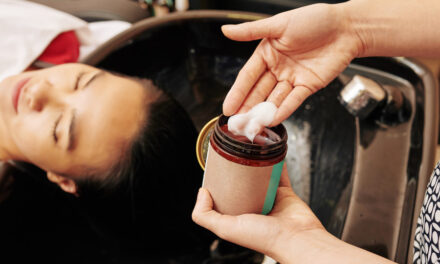
Navigating the world of hair care can often feel like a complex science experiment, especially when terms like low hair porosity appear. However, understanding your hair’s porosity can unlock the secrets to perfect hair care.
This comprehensive guide will dive into what low porosity means for your hair shaft, how to identify it, and the best practices to maintain its health.
What is Low Porosity Hair?
Low porosity hair refers to hair with cuticle layers that lie flat and tightly together, preventing moisture from quickly penetrating the hair strand. This type of hair is considered the opposite of high-porosity hair, which absorbs and loses moisture quickly. Individuals with low porosity often find their hair type to be more resistant to water and products, leading to unique care requirements.
What Causes Low Porosity?
The hair’s porosity is primarily a trait we’re born with, determined by genetics that dictate how tightly the outermost layer of our hair, the hair cuticle, lays. In low-porosity hair, this outermost layer is arranged so closely and flatly that it acts like a tight shield, making it challenging for water and oils to pass through.
Environmental factors like exposure to extreme temperatures and chemical treatments can further seal these cuticles, reinforcing the hair’s natural low porosity tendencies. Therefore, understanding the innate structure of your hair cuticle can help in adopting the proper care practices to manage your hair’s porosity effectively.
Low Porosity Hair Characteristics
When it comes to low-porosity hair, the tightly packed cuticle layers present a unique challenge:
- Hair products often just sit atop the hair, indicating trouble absorbing moisture due to the cuticle’s tightness.
- During washing, you may notice that water beads off instead of soaking in, a classic sign of low-porosity hair struggling with moisture intake.
- Extended drying times are a further symptom, as the sealed-off cuticles trap water, leading to persistently dry hair even after ample time to air dry.
These characteristics are crucial to identifying and understanding low porosity hair, guiding the need for tailored hair care strategies.
10 Tips for Taking Care of Low-Porosity Hair
 Embark on a journey to healthier locks with our top 10 tips, designed to nurture and revitalize low-porosity hair by enhancing moisture absorption and preventing product buildup.
Embark on a journey to healthier locks with our top 10 tips, designed to nurture and revitalize low-porosity hair by enhancing moisture absorption and preventing product buildup.
- Use Lightweight Oils
- Use Heat When Deep Conditioning
- Steam The Hair
- Beware of Protein
- Avoid Heavy Products
- Treat & Prevent Build Up
- Look for Water-Based Products
- Avoid Silicones
- Swap Your Pillowcase
- Shop Specific
Use Lightweight Oils
When nurturing low-porosity hair, opt for lightweight oils that can easily penetrate the cuticle layer, ensuring that the hair cuticles are moisturized without excess weight, allowing hair to retain moisture and stay hydrated. This is particularly beneficial for such hair types, as they need oils that won’t simply coat the surface but will provide lasting nourishment.
Use Heat When Deep Conditioning
Incorporating gentle heat can lift the cuticle layer, which encourages the deeper penetration of moisture into low-porosity hair cuticles, promoting an enhanced ability to retain moisture and keep the hair hydrated. This technique is valuable for all hair types, especially those with low porosity, as it aids in adequate hydration without causing unnecessary stress to the hair.
Steam The Hair
Steaming the hair opens up the cuticle layer, allowing low-porosity hair to better trap moisture inside the hair cuticles and boost hydration to hair types that typically struggle with moisture absorption. This gentle lifting of the cuticles ensures that moisture is retained efficiently, keeping the hair hydrated longer.
Beware of Protein
While protein is crucial for hair strength, it’s essential for those with low-porosity hair to avoid overuse, as it can cause the cuticle layer to stiffen and block the ability of the hair cuticles to retain moisture. Being mindful of protein allows hair types with low porosity to maintain balance, ensuring that the hair stays hydrated and resilient.
Beware of Protein
Protein treatments can overwhelm low-porosity hair products by making them too stiff, so it’s better to use them sparingly; a little can go a long way in strengthening your strands, but too much can prevent moisture from getting in, which is key to keeping your hair soft and manageable.
Avoid Heavy Products
Heavy creams and butter can just sit on top of low-porosity hair, leading to buildup rather than moisture; instead, choose lighter low porosity hair products that won’t weigh down your strands, allowing your hair to breathe and retain the right amount of moisture.
Treat & Prevent Build Up
Regular use of a clarifying shampoo can prevent the accumulation of residue from styling products, which is especially important for the natural hair community; it helps reset the hair, allowing your deep conditioning treatment to work more effectively for healthier hair.
Look for Water-Based Products
Water-based low-porosity hair products are ideal because they’re lighter and can hydrate your hair more effectively; these products help maintain the balance needed for healthier hair without leaving behind a heavy residue.
Avoid Silicones
Silicone-based products can create a barrier on low porosity hair, trapping out the moisture your strands desperately need; instead, seek out natural ingredients that nourish and hydrate without blocking the essential flow of moisture to maintain a healthy scalp.
Swap Your Pillowcase
Switching to a silk or satin pillowcase can make a world of difference for low-porosity hair by reducing friction and helping to prevent moisture loss. At the same time, you sleep, promoting a healthy scalp and better hair management, whether you have low or medium porosity hair.
Shop Specific
Investing in products specifically designed for low porosity hair can significantly enhance your hair care routine; look for items with natural ingredients that support a healthy scalp and are tailored to penetrate tight hair cuticles, promoting optimal health and moisture levels suited to your hair’s unique characteristics.
Tips for All Types of Hair Porosity
 Discover the key to unlocking the full potential of your hair with our expert tips, tailored to cater to all types of hair porosity for optimal health and hydration:
Discover the key to unlocking the full potential of your hair with our expert tips, tailored to cater to all types of hair porosity for optimal health and hydration:
- Apply an oil before shampooing to protect hair strands from harsh cleansing agents.
- Choose a non-sulfate shampoo for gentle cleansing without stripping natural oils.
- Use a deep conditioner balanced with equal parts protein and moisture to maintain hair health.
- Finish with a water-based moisturizer to effectively hydrate hair.
Final Thoughts
Whether you have straight hair, curls, or coils, understanding and catering to your hair’s specific porosity needs is crucial. Conduct a test on hair porosity to gauge how your hair behaves, and personalize your hair care regimen to ensure your tresses can effectively absorb moisture.
With the proper care, managing low-porosity hair is not just possible; it can be a game-changer for your hair’s health and appearance. Dive into the world of enriched hair care with Shop in Vitamins Revive, where our vitamins are crafted with the natural hair community in mind, offering a path to robust, flourishing locks.
We understand the unique needs of diverse hair types, providing targeted solutions that support natural and healthy hair growth. Join our community of hair enthusiasts and begin your journey to more robust, more vibrant hair bolstered by the power of nature’s finest nutrients.
FAQs
How can I tell if I have low-porosity hair?
You might have low porosity hair if water beads up on your hair rather than being absorbed or if products tend to build up on your hair instead of sinking in.
How do you fix low-porosity hair?
To address low porosity hair, incorporate hydrating products that are light and warm treatments to open up the cuticles, allowing better moisture absorption.
Is low porosity hair healthiest?
Low porosity hair can be healthy if managed correctly, requiring less hydration but more effort to ensure moisture and nutrients penetrate the tight cuticle layer.
Is low-porosity hair oily or dry?
Low porosity hair tends to be dry since its tight cuticles make it challenging for oils to penetrate, though it can appear oily if products sit on the surface.
Can you wash low-porosity hair every day?
Wishing low porosity hair is generally unnecessary as it does not readily absorb products or oils, and overwashing can strip away natural oils needed for hair health.









